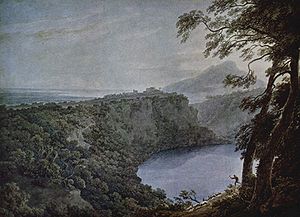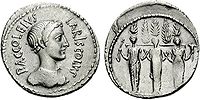- Diana Nemorensis
-
Diana Nemorensis,[1] "Diana of Nemi" also known as “Diana of the Wood”, was an Italic form of the goddess who became Hellenised during the fourth century BCE and conflated with Artemis. Her sanctuary was to be found on the northern shore of Lake Nemi beneath the cliffs of the modern city Nemi (Latin nemus Aricinum). This lake is referred to by poets as speculum Dianae, “Diana's Mirror.” But the town of Aricia was situated about three miles off, at the foot of the Albanus Mons, the Alban Mount, and separated by a steep descent from the lake, which lies in a small crater-like hollow on the mountainside.
Contents
Origin of the legend
According to one of several Hellenising foundation myths, the worship of Diana at Nemi would have been instituted by Orestes,[2] who, after killing Thoas, king in the Tauric Chersonesus (the Crimea), fled with his sister Iphigenia to Italy, bringing with him the image of the Tauric Diana hidden in a faggot of sticks. After his death, the myth has it, his bones were transported from Aricia to Rome and buried in front of the Temple of Saturn, on the Capitoline slope, beside the Temple of Concord. The bloody ritual which legend ascribed to the Tauric Diana is familiar to classical readers; it was said that every stranger who landed on the shore was sacrificed on her altar, but that, when transported to Italy, the rite of human sacrifice assumed a milder form.
No historical or archaeological evidence links these Greek myths to the cultus at Nemi.
Qualities
The temple of Diana Nemorensis was preceded by the sacred grove in which there stood a carved cult image. The temple was noted by Vitruvius as being archaic and "Etruscan" in its form.[3] A. E. Gordon[4] has observed that "the comparatively late date of the excavated remains of the sanctuary[5] does not preclude the dedication of the grove at the end of the sixth century." Andreas Alföldi has demonstrated that the cult image still stood as late as 43 BCE, when it was reflected in coinage.[6]
The Italic type of the tripliform cult image of Diana Nemorensis was reconstructed by Alföldi[8] from a sequence of later Republican period coins he connected with a gens from Aricia (illustration, right) Further examples of these denariiare at Coinarchives.com. In the early examples, the three goddesses stand before a sketchily indicated wood; the central goddess places her right hand on the shoulder of one other goddess and her left hand on the hip of the other. The three are demonstrated to be one by a horizontal bar behind their necks that connects them. Later die-cutters simplified the image. "The Latin Diana was conceived as a threefold unity of the divine huntress, the Moon goddess, and the goddess of the nether world, Hekate," Alföldi interpreted the numismatic image, noting that Diana montium custos nemoremque virgo ("keeper of the mountains and virgin of Nemi") is addressed by Horace as diva triformis ("three-form goddess").[9] Diana is commonly addressed as Trivia by Virgil and Catullus.
The votive offerings, none earlier than the fourth century BCE,[10] found in the grove of Aricia portray her as a huntress, and further as blessing men and women with offspring, and granting expectant mothers an easy delivery.[11] The dedicatory inscription, long disappeared, was copied for its curiosity as testimony to the political union of Latin cities, the Latin league[12] by Cato the Elder and transmitted, perhaps incompletely, by the grammarian Priscianus:
Lucum Dianium in nemore Aricino Egerius Baebius Tusculanus dedicavit dictator Latinus. hi populi communiter: Tusculanus, Aricinus, Lanuvinus, Laurens, Coranus, Tiburtis, Pometinus, Ardeatis Rutulus
Diana Nemorensis was not translated to Republican Rome by the rite called evocatio, as was performed for Juno of Veii, but remained a foreigner there, in a temple outside the pomerium, apparently on the Aventine.[13]
A votive inscription of the time of Nerva indicates that Vesta, Roman goddess of the hearth, home, and family, was also venerated in the grove at Nemi.[14]
Lake and Grove of Aricia
Sir James George Frazer writes of this sacred grove in the often-quoted opening of The Golden Bough, basing his interpretation on brief remarks in Strabo (5.3.12), Pausanias (2,27.24) and Servius' commentary on the Aeneid (6.136) Legend tells of a tree that stands in the center of the grove and is guarded heavily. No one was to break off its limbs, with the exception of a runaway slave, who was allowed, if he could, to break off one of the boughs. Upon breaking off a limb, the slave was then in turn granted the privilege to engage the Rex Nemorensis, the current king and priest of Diana in the region, in one on one mortal combat. If the slave prevailed, he became the next king for as long as he could defeat challengers.[15]
By the time Caligula interfered in the succession of priest-kings, the murder-succession had devolved into a gladiatorial combat before an audience.[16]
Notes and references
- ^ She is Diana nemoralis in the poets: Ovid, Fasti 6.59; Lucan, 6.75; Martial, 13.19.1 and elsewhere.
- ^ Servius, on Aeneid 6.136; less familiar slayers were Hippolytus, after his resurrection as Virbius (Aeneid 7.765-82) or Thoas father of Hypsipyle, after his escape from the Lemnian massacre (Valerius Flaccus, Argonautica 2.301-05)
- ^ Vitruvius, 4.8.4.
- ^ Gordon, The Cults of Aricia, 7f.
- ^ The complicated histories of excavations at Nemi is traced in English in Mysteries of Diana: The Antiquities from Nemi in Nottingham Museums (Castle Museum, Nottingham, 1983). See also F. Coarelli, I santuari del Lazio in età repubblicana (Rome, 1987:165-85).
- ^ Alföldi, "Diana Nemorensis", American Journal of Archaeology (1960:137-44) p 141.
- ^ (CNG)
- ^ Alföldi 1960:137-44; a small marble head from Nemi in the Museo delle Terme was suggested by Enrico Paribeni as an archaising replica of the form the goddess took at Nemi, in American Journal of Archaeology 1961:55f; see also P.J. Riis, "The cult image of Diana Nemorensis" Acta Archaeologica 37 (Copenhagen) 1966:37-65.
- ^ Horace, Carmine 3.22.1.
- ^ Alföldi 1960::141 and bibliography.
- ^ Wissowa, Realencyclopädie der Classischen Altertumswissenschaft.
- ^ Now dated to the late sixth century.
- ^ The Arician origin of Diana of the Aventine is disputed in some ancient sources and by some modern commentators; for an Arician origin, see A. Alföldi, Early Rome and the Latins (1971:85ff).
- ^ C. Bennett Pascal demonstrated that Vesta was not synthesized with Diana Nemorensis, as had been assumed, in "Rex Nemorensis", Numen 23.1 (April 1976:23-39) p 28ff.
- ^ Joseph Fontenrose criticised Frazer's assumption that a rite of this sort actually occurred at the sanctuary of Diana Nemorensis in The Ritual Theory of Myth (University of California Press, 1966) ch. 3.
- ^ "The context of Suetonius' account of Caligula's interference in the succession of the rex Nemorensis implies that it is a theatrical event" (Pascal 1976:30).
Further reading
- Carin M.C. Green, Roman Religion and the Cult of Diana at Aricia (Cambridge University Press, 2007), limited preview online ISBN 0521851580, ISBN 9780521851589
External links
Categories:- Roman mythology
- Ancient Roman religion
Wikimedia Foundation. 2010.



